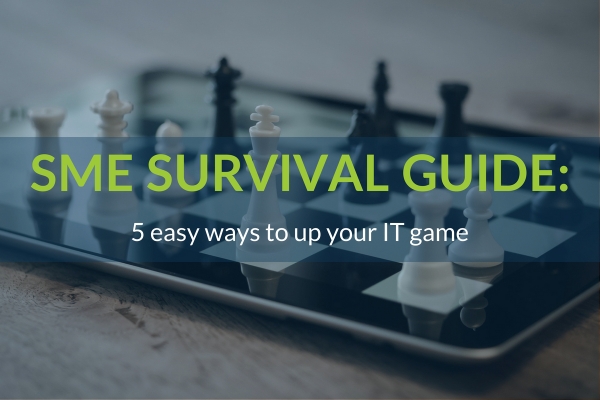SME Survival Guide: 5 easy ways to up your IT game
In an ever-evolving digital world, it’s never been more important for SMEs to ensure they have a safe, savvy and successful IT strategy in place. Although new technologies offer many benefits – both operational and financial – to business owners, there is also an abundance of pesky cyber-threats lurking in the digital space, which SMEs need to do their best to avoid.
With a labyrinth of information and statistics out there, it can be a confusing task to try and streamline your company’s IT approach – unless that is, you follow these five easy steps…
- Identify your cyber-security pitfalls
We recently dispelled the myth that SMEs are less likely than larger organisations to be affected by cyber-crime – the truth is that last year, 50% of small businesses were cyber-crime victims. And that’s just one of the many reasons that SMEs should take securing their systems against hackers seriously.One of the most crucial steps in a hack-proof IT strategy is to evaluate your system. It’s only then – once strengths and weaknesses have been identified – that you can begin to implement tailored, robust mechanisms to keep your staff and critical data safe. - Educate your employees
It’s one thing putting a multi-layer security strategy in place, but without well-briefed staff, it’s more like a sieve than a seal around your company’s IT infrastructure. To ensure that your workforce is on the same page when it comes to digital dos and don’ts, it’s a good idea to make cyber-security awareness a key part of the onboarding process.It’s not just IT security where staff play a pivotal role, they are also paramount when it comes to achieving and maintaining GDPR compliance. For example, if your company falls victim to a data breach, the Information Commissioner’s Office will want evidence that your firm was as well-equipped against cyber-threats as it possibly could’ve been – and this includes keeping personnel up-to-date on the emerging cyber-landscape. - Think ‘what if?’ and back it up
As the famous proverb goes, “fail to prepare and prepare to fail” – how true this is when it comes to upping your IT game!
Data loss is not only inconvenient and disruptive to business operations, but it’s also a costly problem to rectify. Unfortunately, all too often this is overlooked by SME owners, but backing up and replicating sensitive data is a quick and easy way to add a safety net to your IT systems.
In an ideal world, data loss would never happen. But if it does, it’s nice to know that your contingency plan has prevented a logistical disaster. And given that in the event of a large data loss incident, 70% of small firms dissolve within a year, it’s time to start putting this higher up on your priority list!
- Embrace the cloud
This past year, the accelerated rate of digital transformation has seen cloud-based tech feature heavily on the radar of many SME business owners – and for good reason!For smaller organisations, utilising the cloud is a secure, space-saving alternative to clunky systems and hard-copy data. It’s not only a hugely convenient way to successfully offer flexible working options, but it also acts as a space where automated data back-ups can be safely – and quickly – stored. As well as its obvious environmental benefits, cloud computing relies less on human input and more on technology, reducing the risk of human error – such as data misplacement or device loss – occurring. - Give your IT team a helping hand
For SMEs that have an in-house IT team, giving them an extra source of advice and supportcan be an effective way to iron out any inefficiencies within the department, and fortify your digital strategy.
Many SMEs think that having internal IT technicians eliminates the need for external input. However, a blend of expertise is the best option for firms looking to keep abreast of the latest digital trends and technologies – as well as harness them in a way to free up and enhance their in-house resource.
Is your SME’s IT strategy in need of some TLC? Get in touch with the Q2Q experts for a comprehensive system assessment and to fully get to grips with your digital infrastructure.



